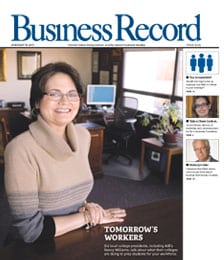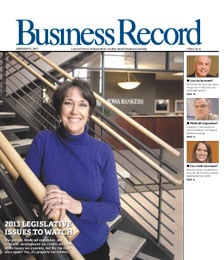The business of Powerball

Central Iowa residents are so accustomed to seeing local personality Mike Pace conduct the Powerball drawings on television twice each week that they may not realize that the drawings are also viewed by players in 26 other states, plus the District of Columbia and the U.S. Virgin Islands. They also may not know that Powerball was invented by an Iowan, Ed Stanek, or that the non-profit organization that administers it, the Multi-State Lottery Association, or MUSL, is based in Urbandale.
Beyond the hype of multimillion-dollar jackpots, the inner workings of Powerball are in many respects more similar to those of an insurance company, as the 29 lotteries that are members of MUSL work together to minimize risks and maximize the revenues of the high-stakes games they administer.
MUSL (pronounced muscle) began with a staff of four in West Des Moines in 1988 to administer the nation’s first multistate lottery game, Lotto America. About $80 million in tickets were sold that first year by seven member state lotteries. Powerball, which on April 22 celebrated its 13th anniversary, sold approximately $2.2 billion in tickets last year through its 29 member lotteries.
“Our mission has always been to allow our members to offer products that they would not otherwise be able to offer themselves,” said Chuck Strutt, MUSL’s executive director. “No individual state, for instance, would be able to have the jackpot that Powerball offers.”
Now located in leased office space in Urbandale, MUSL’s 12 person staff handles the legal, accounting and administrative functions for Powerball, as well as administering Powerball.com and 12 of its member lotteries’ Web sites. MUSL also manages several smaller multi-state games for its members, including the eight-state Hot Lotto, which is played in Iowa, along with Wild Card and Two by Two.
The non-profit organization, which is owned and directed by its 29 lottery shareholders, is being increasingly challenged by its closest competing multi-state lottery, Mega Millions. At the same time, MUSL has faced the financial challenge of record-low interest rates, which have shrunk the earnings it receives on the short-term investments it makes with money it’s accruing for jackpots.
Earlier this month, MUSL announced it will raise Powerball’s guaranteed starting jackpot from $10 million to $15 million on Aug. 28, as well as doubling the top prize for a winning Match 5 pick to $200,000. That latter prize could be multiplied to as much as $1 million if the player purchases the Power Play option. To pay these larger prizes and because more states have joined Powerball within the past few years, the odds of winning the game will be lengthened by adding two white balls for a total of 55. The red Powerball will continue to be selected from a pool of 42.
The third change that’s been made to the Powerball game since it began 13 years ago, the higher and faster-growing jackpots are part of an ongoing effort to deal with “jackpot fatigue,” Strutt said.
“One of the things the development committee learned years ago that has made Powerball a success has been the concept to pay out a lot of money at the high end, and a lot of money at the low end,” he said. “They call that the barbell technique. That’s been very successful, and we’ve begun to see a lot of other lottery games recognize that technique and are becoming more successful because of that. (Powerball’s) new game design will continue to do that.”
Iowa Lottery CEO Ed Stanek, who developed the original concept for a multi-state lottery, said increasing the odds slightly with the additional balls will benefit each of MUSL’s member lotteries.
“With the addition of that much population, all of whom were eager to buy Powerball tickets, we were oversubscribing the game,” said Stanek, who chaired the development committee that engineered the changes. “That was lowering the average jackpot and lengthening the turnover time between jackpots. The mathematics of the change dictated that the game will return to the way it was prior to those states joining.”
It will also position Powerball for further growth, as the organization looks toward the possibility of adding more states that are considering lotteries and may join the multistate lottery, he said.
The return on investment in Powerball varies from state to state.
“In some of the smaller states, Powerball is their big game and they make most of their money from those sales,” said Bret Toyne, MUSL’s chief financial officer. “In larger states, they make most of their money from instant tickets, or other products.”
Typically, a lottery that introduces Powerball may cut into its regular sales by as much as 30 percent, but lotteries find that it provides an addition to the product mix that boosts their overall ticket sales, as well providing a higher profit margin.
“Generally, a state lottery’s profit margin on a Powerball ticket is equal to or greater than their profit margin for any other of their games because MUSL has relatively low overhead and advertising costs,” Toyne said. “So typically the profit margin for a Powerball ticket will be at the high end for their sales.”
From each dollar of Powerball ticket revenue, half goes to the local lottery from which the player bought the ticket, and half is paid out in prizes.
“In the case of a multistate game, each state lottery is responsible for paying all of the prizes except for the grand prize,” Toyne said. “So a multi-state game is truly a shared jackpot game. Approximately 32 cents of every dollar is remitted to MUSL and held in trust and accumulated with the other dollars from sales nationwide, until there is a grand prize winner.”
The 32 cents represents the average amount that MUSL accrues over time from its member lotteries. Each state pays out its lower-tier prizes and then sends MUSL the remainder. Sometimes, however, there’s no money left over in a particular lottery’s pool and MUSL has to send money back to it.
“That’s one of the cases where there is some risk of having a game with large set prizes at the secondary level,” Toyne said. “So (the state lotteries) share that risk.”
Just two weeks ago, the strength of the entire Powerball system was tested when a set of mass-produced fortune cookies with the same lottery number pick on them resulted in an unexpected flood of mini-jackpot winners.
“We should have had four second-tier winners of $100,000 each,” Stanek said. “Instead of that, we had 110 winners. But it was worse than that. A 5 came up (for the multiplier), so 29 of them got $500,000 cash. Our liability on that drawing was almost $20 million higher than predicted.”
Using a self-insurance fund Stanek developed for Powerball prior to its launch, the system was able to pay out the prizes.
“It’s an example of how banding together can cover a liability that otherwise couldn’t be covered,” he said. “In insurance, it’s a concept called reinsurance.”
Three years ago, MUSL instituted a cap on Powerball’s jackpot increases so that the grand prize will never increase by more than $25 million over the previous record, which currently stands at $314.9 million.
“So we get the advantage of having a record jackpot more often,” Strutt said, “and records are what capture attention.”
POWERBALL FACTS
Fiscal year 2004 ticket sales: $2.26 billion.
Number of lotteries that are Powerball members: 29.
Average jackpot won in Powerball since 1992: $34.6 million.
Record jackpot: $314.9 million, won in West Virginia on Dec. 25, 2002.
Portion of Iowa Lottery sales that are Powerball: 25 percent.
Iowa’s share of total Powerball sales: 2.5 percent.







